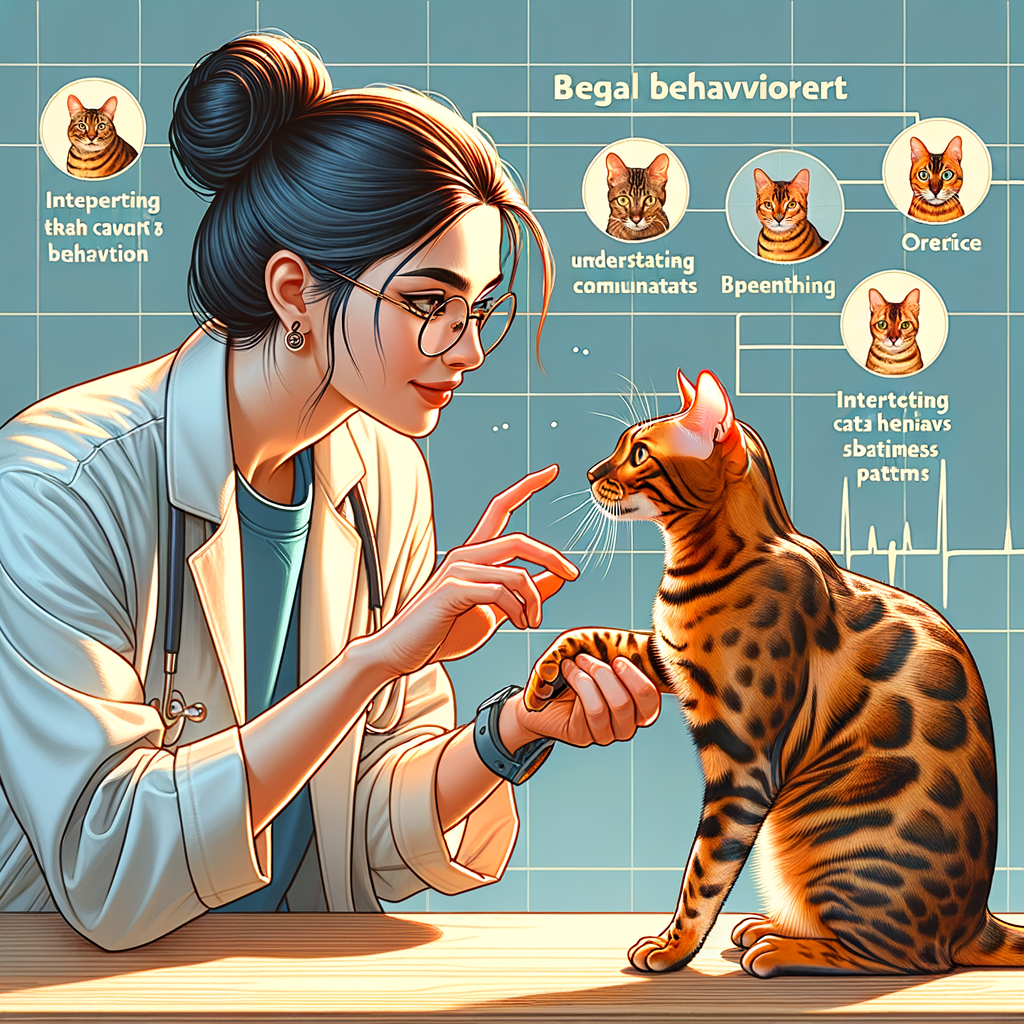
Introduction to Bengal Cat Behavior
Understanding the behavior of Bengal cats can be a fascinating journey. These unique felines are known for their striking appearance and dynamic personality. Let’s dive into the world of Bengal cats and explore their behavior patterns.
- Overview of Bengal Cat Behavior
- Common Bengal Cat Behavior Patterns
Bengal cats are known for their high energy levels and playful nature. They are very active and require a lot of mental and physical stimulation. Unlike some other cat breeds, Bengals are very social and enjoy the company of their human family members. They are also known to be quite vocal, often communicating their needs and desires through a variety of sounds.
These cats are intelligent and curious, often showing interest in their surroundings and enjoying interactive toys. They are also known for their love of water, which is quite unusual for cats. You might find your Bengal cat splashing in the water bowl or even joining you for a bath!
One common behavior pattern of Bengal cats is their love for climbing. They enjoy high places and you’ll often find them on top of cupboards, shelves, or even doors. Providing a cat tree or some high perches can be a great way to keep your Bengal cat entertained and satisfied.
Bengal cats also have a strong hunting instinct. They love to chase and catch toys, mimicking the hunting behavior of their wild ancestors. Interactive play sessions with toys that move and stimulate their hunting instincts can be a great way to keep them active and engaged.
Another common behavior is their vocalization. Bengal cats are known to be quite talkative and use a variety of sounds to communicate. They might meow, purr, hiss, or even make chirping sounds. Paying attention to these sounds can help you understand your Bengal cat’s needs and moods.
In conclusion, Bengal cats are active, social, and intelligent creatures. Understanding their behavior can help you provide a stimulating and satisfying environment for them. So, let’s continue this journey and learn more about bonding with Bengal cats in the next section.
Understanding Cat Cues
When it comes to understanding our feline friends, especially Bengal cats, it’s essential to pay attention to their cues. These cues can provide valuable insights into their mood, health, and overall well-being. Let’s delve deeper into interpreting Bengal cat behavior.
Interpreting Bengal Cat Behavior
Bengal cats are known for their unique and expressive behavior. By recognizing and decoding their behavior signs and communication, you can better understand your Bengal cat and build a stronger bond with them.
- Recognizing Bengal Cat Behavior Signs
- Decoding Bengal Cat Communication
Bengal cats are highly active and playful. They often show their enthusiasm by running around, jumping, and playing with toys. However, if your Bengal cat is less active than usual, it may be a sign of discomfort or illness. Other behavior signs to watch out for include excessive grooming, hiding, or changes in eating habits.
Bengal cats communicate in various ways. A purring Bengal cat is usually content and comfortable, while hissing or growling may indicate fear or aggression. Paying attention to their body language, such as the position of their ears and tail, can also help you understand their feelings. For example, a Bengal cat with its tail puffed up and ears flattened is likely feeling threatened.
Remember, every Bengal cat is unique, and what may be normal behavior for one might not be for another. The key to understanding your Bengal cat is patience, observation, and a lot of love.
Case Study: Understanding Your Bengal Cat
Let’s delve into a case study to better understand the behavior of Bengal cats. We’ll explore two examples that highlight their unique behavior patterns in different situations.
-
Example 1: Bengal Cat Behavior in Different Situations
Meet Bella, a 3-year-old Bengal cat. Bella’s owner noticed that her behavior varied greatly depending on the situation. For instance, when visitors came over, Bella would hide under the bed, showing signs of fear and anxiety. However, during quiet evenings at home, Bella would be playful and affectionate, often seeking her owner’s attention.
This behavior is not uncommon in Bengal cats. They are known to be sensitive to their environment and can react differently depending on the situation. Understanding this can help owners create a comfortable environment for their Bengal cats.
-
Example 2: Interpreting Unique Bengal Cat Behavior Patterns
Next, let’s look at Max, a 5-year-old Bengal cat. Max’s owner noticed that he had a unique behavior pattern. Max would often flick his tail when he was excited, and his eyes would dilate when he was ready to play. He would also make a chirping sound when he spotted birds from the window.
These unique behavior patterns are part of what makes Bengal cats so fascinating. By paying close attention to these behaviors, Max’s owner was able to understand his needs and moods better.
Understanding your Bengal cat’s behavior can be a rewarding experience. It allows you to build a stronger bond with your cat and provide them with the care they need. Remember, every Bengal cat is unique, and their behavior can vary. The key is to be patient and observant.
Bonding with Bengal Cats
Bonding with your Bengal cat is a rewarding experience that can lead to a lifetime of companionship and mutual understanding. It’s important to remember that each Bengal cat is unique, and the bonding process may take time and patience. Here are some tips to help you bond with your Bengal cat.
Bengal Cat Bonding Tips
- Building a Bond with Cats: Step by Step Guide
- Key Takeaways for Successful Bonding
Step 1: Understanding Your Cat’s Behavior – Bengal cats are known for their playful and energetic nature. Observe your cat’s behavior to understand their likes and dislikes.
Step 2: Creating a Safe Environment – Make sure your cat feels safe and secure in their environment. This includes providing a comfortable bed, clean litter box, and plenty of toys.
Step 3: Spending Quality Time – Spend quality time with your cat. Play with them, groom them, and talk to them. This helps to build trust and strengthen your bond.
Step 4: Positive Reinforcement – Reward your cat with treats and praises when they show positive behavior. This encourages them to continue behaving in a similar manner.
Patience is Key – Bonding with a Bengal cat takes time. Be patient and give your cat the space they need to feel comfortable.
Consistency is Important – Be consistent with your interactions. This helps your cat understand what to expect from you, which can strengthen your bond.
Respect Your Cat’s Boundaries – Understand and respect your cat’s boundaries. If they seem uncomfortable or scared, give them space and try again later.
In conclusion, bonding with a Bengal cat requires patience, understanding, and respect. By following these tips, you can build a strong bond with your Bengal cat and enjoy a rewarding relationship.
Case Study: Successful Bonding Experiences
Let’s delve into some real-life examples of successful bonding experiences with Bengal cats. These stories highlight the importance of patience, understanding, and respect in building a strong bond with these beautiful creatures.
- Example 1: Bonding with a Shy Bengal Cat
- Example 2: Bonding with an Energetic Bengal Cat
Meet Bella, a shy Bengal cat. Her owner, Sarah, was initially worried about Bella’s reserved nature. However, she soon realized that Bella needed time to adjust to her new surroundings. Sarah made sure to give Bella her space, while also providing gentle reassurance. She would sit near Bella, softly speaking to her and offering treats. Over time, Bella began to trust Sarah and they formed a strong bond. This case study shows that patience and understanding are key when bonding with a shy Bengal cat.
On the other hand, we have Max, an energetic Bengal cat. Max’s owner, John, found that Max was always on the move, exploring and playing. John decided to join in on Max’s adventures, engaging him in interactive play sessions with toys and puzzles. This not only helped Max burn off his energy, but also allowed John and Max to bond over shared activities. This case study demonstrates that bonding with an energetic Bengal cat requires active participation and engagement.
In conclusion, whether your Bengal cat is shy or energetic, bonding is a process that requires time, patience, and understanding. By respecting their unique personalities and needs, you can build a strong, lasting bond with your Bengal cat.
Conclusion: Decoding the Mystery of Bengal Cat Behavior
As we conclude our journey into the world of Bengal cat behavior, it’s essential to remember that every Bengal cat is unique. Their behavior is a mix of their breed characteristics, their environment, and their bond with their human companions. Understanding their cues and bonding with them can significantly enhance your relationship with your Bengal cat.
- Recap of Understanding Cat Cues and Bonding with Bengal Cats
- Final Thoughts on Bengal Cat Behavior
Throughout this article, we’ve explored the various cues that Bengal cats use to communicate. From their vocalizations to their body language, these cues provide valuable insights into their thoughts and feelings. We’ve also discussed the importance of bonding with your Bengal cat. This bonding process not only strengthens your relationship but also helps you better understand their unique behavior patterns.
Bengal cats are a fascinating breed with a rich behavioral repertoire. Their active and playful nature, combined with their high intelligence, makes them a joy to live with. However, understanding their behavior requires patience and observation. Remember, the key to decoding the mystery of Bengal cat behavior lies in building a strong bond and paying close attention to their cues.
In conclusion, Bengal cats are not a mystery once you understand their cues and establish a strong bond with them. They are expressive, intelligent, and full of energy, making them wonderful companions. So, take the time to understand your Bengal cat, and you’ll be rewarded with a deep, fulfilling relationship.






